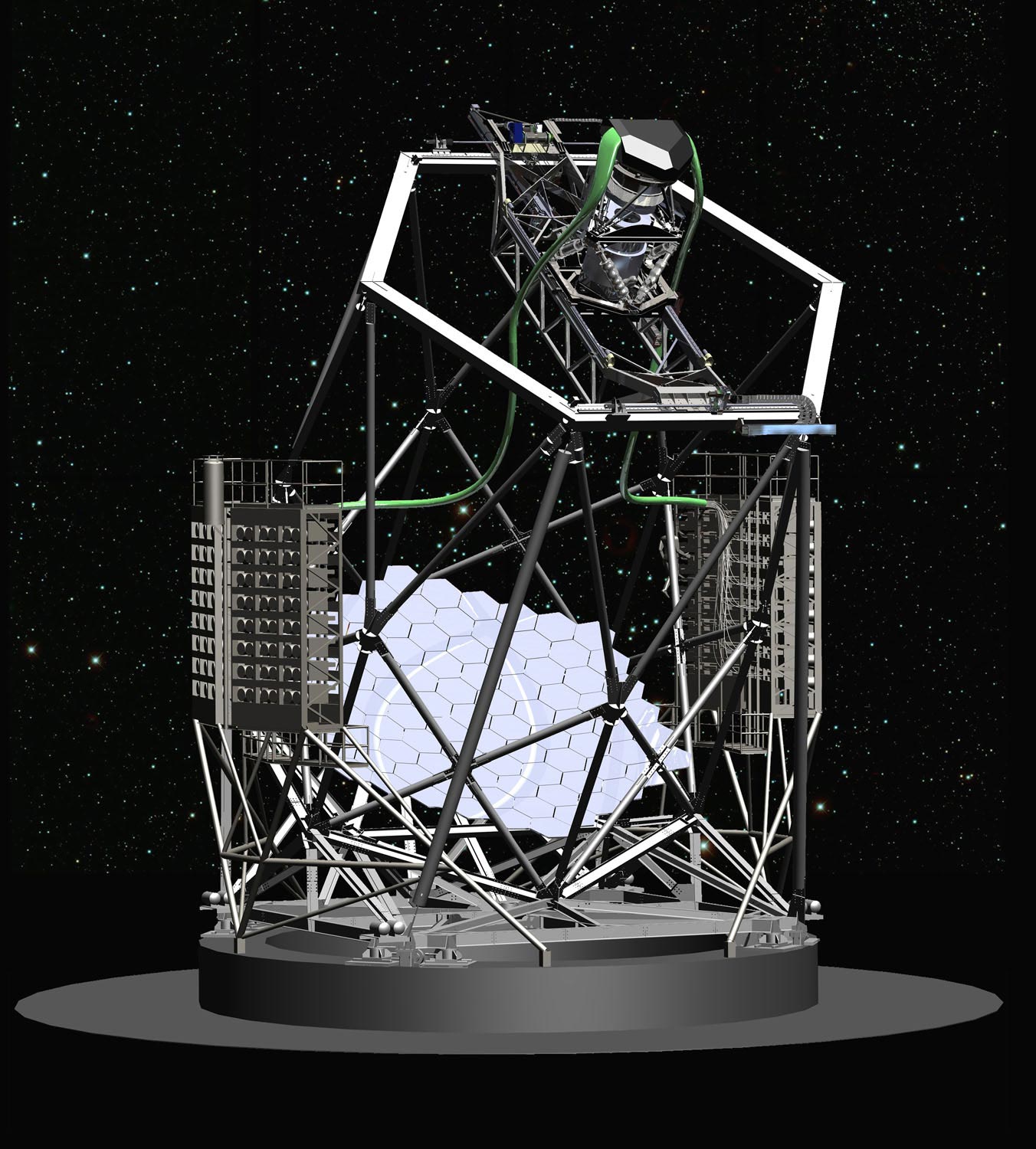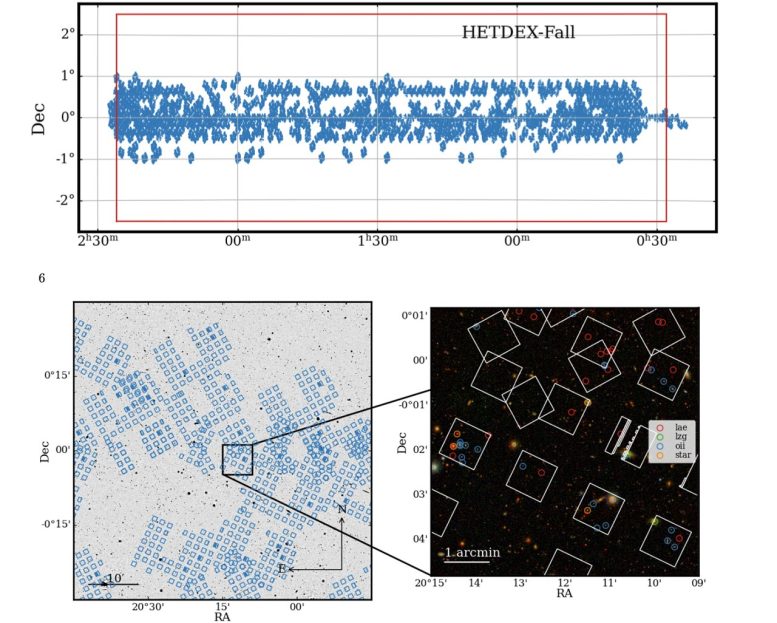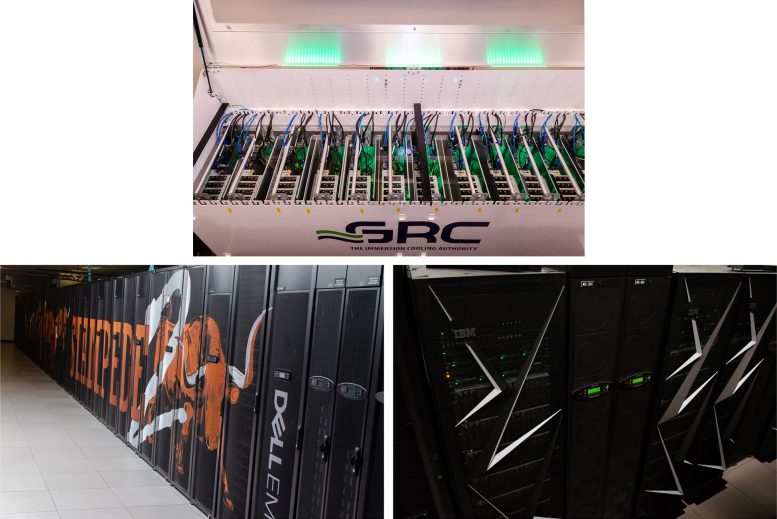By University of Texas at Austin, Texas Advanced Computing Center
February 17, 2023

Illustration showing the Hobby-Eberly Telescope and VIRUS spectrograph pairs mounted on either side of the telescope. Credit: McDonald Observatory/HETDEX Collaboration
Texas Advanced Computing Center (TACC) systems support catalog release of over 200,000 new star and galaxy locations.
Astronomers have barely scratched the surface of mapping the nearly endless stars and galaxies of the heavens. Using supercomputers and the help of thousands of citizen scientists around the world, researchers with The University of Texas at Austin have now revealed the locations of more than 200,000 new astronomical objects. Their goal is to map even more and use that knowledge to predict the ultimate fate of the universe.
The Hobby-Eberly Telescope Dark Energy Experiment (HETDEX) has scanned the dark skies of the Davis Mountains in West Texas since 2017 with a keen eye toward capturing spectroscopic data on Lyman-alpha frequency light from neutral hydrogen emission in galaxies over 10 billion light years away. These galaxies emit a signature wavelength of light from hydrogen that signals to astronomers the intense creation of new stars.
The HETDEX collaboration involves a large team including astronomers, engineers, technicians, and graduate students from six academic institutions in the United States and Germany.

The Hobby-Eberly Telescope Dark Energy Experiment (HETDEX) announced their first publicly released catalog mapping over 200,000 astronomical objects, which include distant stars and galaxies bursting with star formation. HETDEX tiles the sky, collecting spectroscopic data that is used to pinpoint location of a star or galaxy and its distance from Earth. (Top) Sky coverage of the planned HETDEX Fall field (in red) and the footprint of this catalog release (in blue), with stars, Lyman-alpha emitting (lae), [O II]-emitting (oii), and low-z galaxies of non [OII] emission (lzg) color coded. Credit: Credit: Erin Mentuch Cooper et al 2023 ApJ 943 177.
For the first time, the researchers have cataloged astronomical objects — mapping over 51,863 Lyman-alpha-emitting galaxies at high redshift; 123,891 star forming galaxies at lower redshift; 5,274 non-emission line galaxies at low redshift; and 4,976 active galactic nuclei (AGN) — bright spots that signal the presence of black holes.
The paper describing the catalog was published on February 7, 2023, in The
TACC’s Maverick2 (top), Stampede2 (left), Corral (right) supercomputers. Credit: TACC
A star’s redshift tells astronomers how fast a star is moving away from the Earth because its frequency, akin to its color, gets lower as it moves away, much like the horn of a train as it passes by.
The faster a star moves away, the farther away it is. That relationship between speed and distance, called Hubble’s Law, can pin down a galaxy’s location and allows astronomers to create a 3D map of over 200,000 stars and galaxies with HETDEX.
“This is only a small percentage of what we will find, but it’s a good start. Ultimately, HETDEX aims to map one million red-shifted galaxies,” Cooper said.
HETDEX is unique from previous large sky surveys because it’s a non-targeted survey, blanketing the sky and collecting spectra from the 35,000 fiber optic cables of the Visible Integral Field Replicable Unit Spectrograph (VIRUS).
VIRUS takes starlight from distant galaxies and splits the light into its component colors like a prism does. HETDEX tiles the sky, collecting 35,000 spectra in a moon-sized swath of sky and moving from spot to spot. It collects about 500-600 hours of observations each year for its survey data.
“We have the largest spectroscopic instrument on the planet, and we’re doing one of the longest surveys in terms of time,” Gebhardt said. “To analyze this data, we need the fastest computer we can get our hands on, and that’s where TACC comes in. TACC does all the data storage and all the data analysis for this giant survey.”
The data from the telescope goes straight to the TACC Corral data storage system via high speed lines at 100 Gigabits/second.
“TACC has worked hard with us to streamline our system, and it’s just working fantastically. We can process years of data in a couple of days, maybe a week of time on TACC systems. And we do it multiple times because we keep adjusting and improving our methods,” Gebhardt added.
HETDEX used the Maverick and Stampede2 supercomputers of the Texas Advanced Computing Center, a leading academic supercomputing center at UT Austin. Stampede2 is funded by the National Science Foundation as a shared resource for thousands of scientists across the US. They helped process and analyze about 60 terabytes of image data on TACC’s Corral system.
What’s more, Cooper and colleagues have worked with TACC to create JupyterHub public access to the data.
“Anyone with any academic credentials can get a TACC account and go on through a web browser to access our data. We’re going to let them access all of our data. This is just the catalog right now. But, the future is going to offer a legacy potential of the science from HETDEX. TACC is helping setting that up,” Cooper said.
One interesting highlight from the catalog is the identification of an active galactic nuclei (AGN) with strong Lyman-alpha light emission. Gebhadt co-authored a study led by UT Austin astronomy post-doctoral researcher Chenxu Liu, published in November 2022 in The Astrophysical Journal. It presents intriguing evidence of a

0 Comments :
Post a Comment